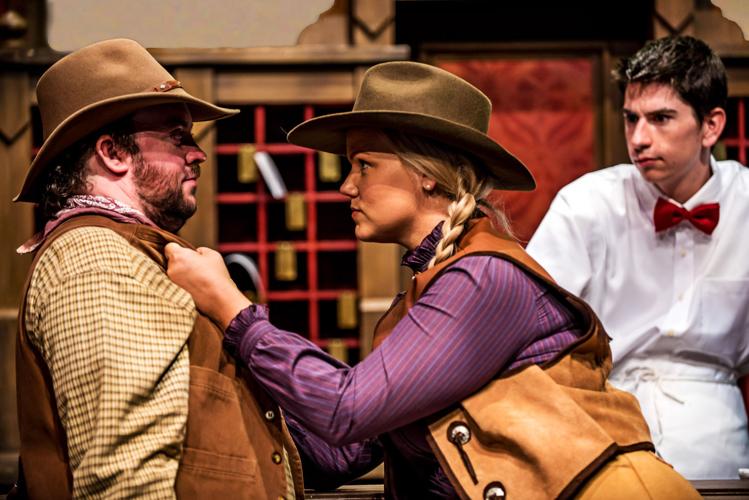Arizona Opera opens its 2015-16 season in Tucson next weekend, and opera companies throughout the country will be paying attention.
The company will be the first in the United States to mount Hungarian composer Emmerich Kálmán’s 1953 operetta “Arizona Lady,” a story about a Hungarian immigrant who tries to save her Tucson ranch by racing her prized horse in the Tucson Rodeo.
But that is not why everyone’s paying attention.
They are watching to see if Arizona Opera’s grand experiment “Arizona Bold” will bear fruit.
“Arizona Lady” is the second performance of “Arizona Bold,” a four-year programming and fundraising initiative that Arizona Opera launched last season with the mariachi opera “Cruzar la Cara de la Luna (To Cross the Face of the Moon).” The company has committed to programming lesser known or completely unknown works that are relevant to Arizona and its heavily Latino population through the 2017-18 season. All of the programs are part of the company’s subscription season.
“Arizona Bold is about presenting work that is outside of that common exploration of well understood hit operatic titles, but in our case we are able to entice people to the opera house who would otherwise not come by presenting things of particular relevance,” said Ryan Taylor, the company’s general director and driving force behind the initiative.
“Cruzar,” which opened last season, was hardly a box office smash, although “by all accounts it made about a third more money than “HMS Pinafore,” which opened the 2013-14 season, and “Lucia di Lammermoor,” the 2012-13 season opener. Both are considered among the standard opera repertoire, programmed in regular rotation on subscription season.
Arizona Opera anticipates it could lose money on the productions, which is why part of the “Arizona Bold” initiative calls for raising $5 million over four years to cover the drop in ticket sales, Taylor said. In the year since it launched the initiative in September 2014, the company has raised more than $3.1 million, he said.
Arizona Opera’s four-year commitment has attracted the attention of Opera America, the national service organization with its pulse on opera in North America. It has been touting Arizona Opera in conferences and conference calls, praising the company for taking a nationwide trend of mixing up programming to such lengths.
“We have certainly followed it and, yes, it is getting attention,” said Opera America President and CEO Marc A. Scorca. “The multiyear programming initiative that is looking at new and unusual repertoire with a focus on works that are specific to Arizona and specific to a Latino audience is really remarkable. We not only have admired it but we have presented presentations on it at national conferences and talks.”
Arizona Opera is not alone in shaking up the opera model, Scorca said, noting that plenty of companies have combated what he calls “repertoire fatigue” — programming warhorse titles year in and year out — with new repertoire. But none have set in motion a plan that spreads over four seasons, he said.
“The modern audience doesn’t have the appetite any more to see the same titles over and over and over again,” said Taylor. “If we were to present only titles from Mozart, Verdi and Puccini then it would be like having a statewide art museum that only presents sculptors or modern painters.”
“I’ve seen the incredible success in other places of opera companies reaching out into their communities not in a traditional outreach way,” added conductor Kathleen Kelly, who is in the pit for “Arizona Lady.” “It’s a deeper conversation about how to use the medium of opera to reach out to their communities and use opera so that it’s not a museum medium.”
“Arizona Bold” comes a year after Taylor helped lead Arizona Opera away from the brink of financial disaster. He inherited the debt-ridden operation at the close of the 2012-13 season. The company owed $3 million in long-term debt — $1 million owed immediately to pay its vendors — and no endowment to fall back on.
Taylor and the opera board quietly and quickly raised $1 million in its inaugural Million Dollar May campaign. The money ensured that Arizona Opera would have a 2013-14 season.
In April 2014, Arizona Opera signed a four-year endorsement deal with CopperPoint Mutual to erase an outstanding $1.6 million revolving line of credit with the state’s largest workers’ compensation insurer. That coupled with a second Million Dollar May campaign in summer 2014 effectively wiped out the company’s debt, paving the way for Taylor to focus on the artistic end.
In addition to “Arizona Lady,” Arizona Opera will mount “Florencia en el Amazonas” by the late Mexican composer Daniel Catán in November as part of “Arizona Bold.” Operas in the works include performing the world premiere of “Riders of the Purple Sage,” based on the Zane Grey novel; Kevin Puts and Mark Campbell’s “Silent Night”; and “Dead Man Walking,” the Jake Heggie and Terrence McNally opera based on the book by Sister Helen Prejean.







